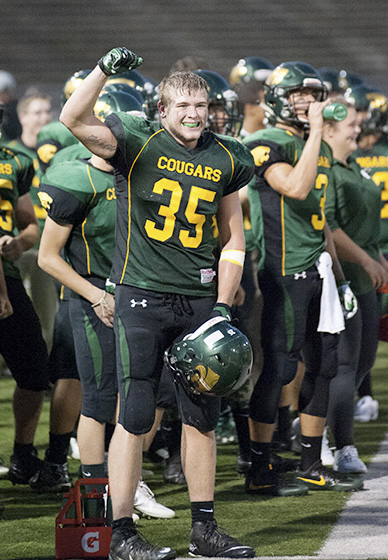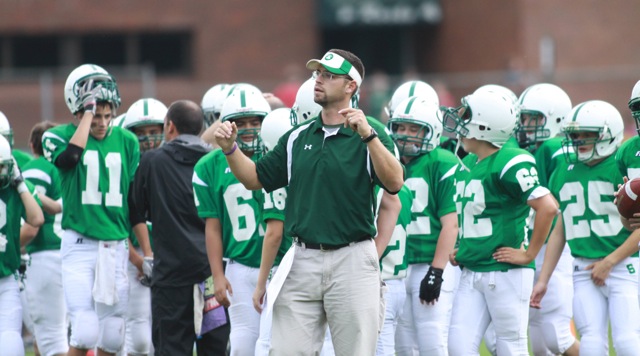The 5 leaders every team needs
Finding and developing just one effective leader can be challenging enough for most teams. However, in actuality, you really need five kinds of leaders if your program is going to be successful on and off the playing field: performance leaders, locker room leaders, social leaders, organizational leaders and reserve leaders.
While some of the five leadership functions can overlap and be fulfilled by the same person, each of them has a slightly different skill set and impact on your team. Let’s take an in-depth look at each of the five kinds of leadership.
 1. Performance leaders (competition captains).
1. Performance leaders (competition captains).
Performance leaders are your primary leaders during competition. They take charge of your team in practice and competitive settings to focus people and keep them on task. As competition captains, they provide the strong vocal leadership necessary to help your team perform to its potential during practices and game day.
Your performance leaders need to be highly results-oriented. They set the tone with their own work ethic and make sure their teammates play with a high level of intensity and accountability. Your performance leaders are typically your most committed and competitive athletes on the team. Because they tend to have a certain edge about them, they raise the level of play of everyone around them. They are serious about success and very motivated to accomplish something special with your program.
University of North Carolina women’s soccer coach Anson Dorrance said, “The most attractive type of leadership to me is the student-athlete who is a coach on the field. I want a driving verbal force who won’t let standards slip. That’s how teams with ordinary talent can win championships. Without leadership, even a team with great talent will struggle to become a champion.”
Unfortunately, many teams lack a strong vocal performance leader. Some athletes shy away from this role because they lack confidence in their leadership skills. They don’t demand enough from their teammates because they worry too much about what others think of them.
This lack of leadership then puts the onus on the coaching staff to continually set the tone rather than the athletes stepping up and taking responsibility and ownership of it themselves. Worse, when the team struggles in competition, no performance leaders step up to calm and refocus the team to get them back on track. The team often crumbles when adversity hits because it lacks competition captains.
2. Locker room leaders (culture captains).
University of Arkansas pitching coach Dave Jorn said, “A lot of your success and failure is going on in the locker room. Your leaders are key to managing the locker room.”
Locker room leaders serve as the critical creators, champions and caretakers of your team’s culture. Through their words and deeds on a daily basis, trusted locker room leaders mold, monitor and maintain your team’s culture into one that is positive and productive for your program. In their role as culture captains, they determine and dictate what is acceptable and unacceptable in your program.
Effective locker room leaders take pride in your program’s culture and do everything they can to enhance, protect and preserve it. If someone acts in a way that is outside of what is considered appropriate, this leader steps in and sets the person straight. They willingly and quickly confront those who do not act in a way that is aligned with your program’s vision, values and standards. Often, you’ll find that effective locker room leaders contribute more to your program’s success with their leadership than they do with their individual physical talent.
It’s critical that the coaching staff and the locker room leaders are on the same page and support each other. Following a tough practice or frustrating loss, the locker room is often filled with upset individuals, disgruntled subs, critical comments and seeds of dissension. It’s during these times when your locker room leaders need to step up, be vocal and keep the team positive and productive. They need to constructively confront the snipers and gripers on the team so that they don’t infect the fence-sitters. Left unchecked, these pessimistic attitudes and negative comments corrode your team’s culture and chemistry.
Destructive locker room leaders are better described as ring leaders. They are not bought in to the vision, values and standards of the positive team leaders and coaching staff and often have their own stubborn way of doing things. They stir up problems, cause drama and instigate issues in hopes of bringing everyone to their side. Or they often disdain and undermine the coaches and sometimes mutinously attempt to orchestrate an ouster of the staff.
Usually, your productive locker room leaders are the senior and veteran athletes on your team who are invested in your program’s success because they see that their time left to accomplish something special is fleeting. Their advanced age often provides them with a greater level of maturity as well, so they have less tolerance for the shenanigans that could destroy your team.
3. Social leaders (chemistry captains).
Your social leaders lead the charge on building and maintaining your team’s chemistry, hence the term “chemistry captains.” They focus on the relationships of your team and how well people bond together. They look to connect with teammates on a regular basis and often plan various social events to get everyone to get to know each other at a deeper level.
 Effective social leaders intentionally build strong relationships with the various subgroups on your team. Subgroups occur naturally within a team based on positions, year in school, hometowns, race, etc. Good social leaders are able to move in and out of each of the subgroups on your team. In this way they are the glue that bonds the various subgroups together, rather than allowing them to be exclusive and destructive cliques.
Effective social leaders intentionally build strong relationships with the various subgroups on your team. Subgroups occur naturally within a team based on positions, year in school, hometowns, race, etc. Good social leaders are able to move in and out of each of the subgroups on your team. In this way they are the glue that bonds the various subgroups together, rather than allowing them to be exclusive and destructive cliques.
Destructive social leaders often create and promote contentious cliques, where certain segments of your team covertly battle each other, sometimes more intensely than they do your opponents. Further, destructive social leaders make your team’s social life a priority. While people might get along and have a good time at the parties they plan and host, your team’s success and reputation typically nose dive.
4. Organizational leaders (campus captains).
Organizational leaders get involved in the various clubs and organizations on campus. They represent your team or athletic department on the Student-Athlete Advisory Council, student council and a variety of other campus related organizations. Acting as your campus captains, these leaders keep your team involved and engaged with what is happening on campus and in the community. They often plan various campus programs and community service events.
Poor organizational leaders miss meetings or represent your team in an embarrassing way in your athletic department. Their apathy and irresponsibility can quickly give your program a poor reputation among athletic administrators and community leaders.
5. Reserve leaders (sub captains).
An often-overlooked yet important kind of leader are your reserve leaders. They lead the second- and third-string athletes on your team. Because they don’t play much or receive a lot of outside attention, your reserves can be a very volatile segment of your team. Keep in mind that too many disgruntled subs can torpedo your team.
Baseball manager Casey Stengel once said, “The secret of successful managing is to keep the five guys who hate you away from the four guys who haven’t made up their minds.” Your reserve leaders assist in the process of managing expectations and the frustration that can arise with limited playing time for your substitutes.
Numbers-wise, your reserves make up a significant portion of your team, comprising sometimes one-third to one-half of your total roster. So you need to find a respected leader of your reserves who can help them understand their important yet limited role and quell any dissension that might rise up during the course of the season.
Great reserve leaders create a sense of pride in their group’s unique role. As an example, the Carolina men’s basketball reserves have even named themselves “Blue Steel” and have created a cult-like following for their unique contributions to the team. Encourage your reserve leaders to develop a sense of positive pride and perspective with their fellow substitutes on your team.
Invest the time to chat with your coaching staff about each of the leader types and how they impact your team. Slot your current leaders into each category and rate them on a scale of one to 10. If you are like most teams, you will have some strengths but some deficiencies and voids. Make a conscious effort to develop the leadership areas where your team is weak and be sure to praise the effective leaders who are doing a solid job for you.
Follow up with the various leaders on your team and express your appreciation for the important leadership roles they play. Discuss with them the roles and responsibilities of each kind of leader. Collectively decide which of your leaders will be responsible for each role. Be sure they are committed to fulfilling these roles for your team.
A lot of the leadership roles will fall to your team captains, but you should be able to allocate some of the social, organizational and reserve roles to other leaders on your team.
For more info on helping your team win championships, visit www.JanssenSportsLeadership.com.





